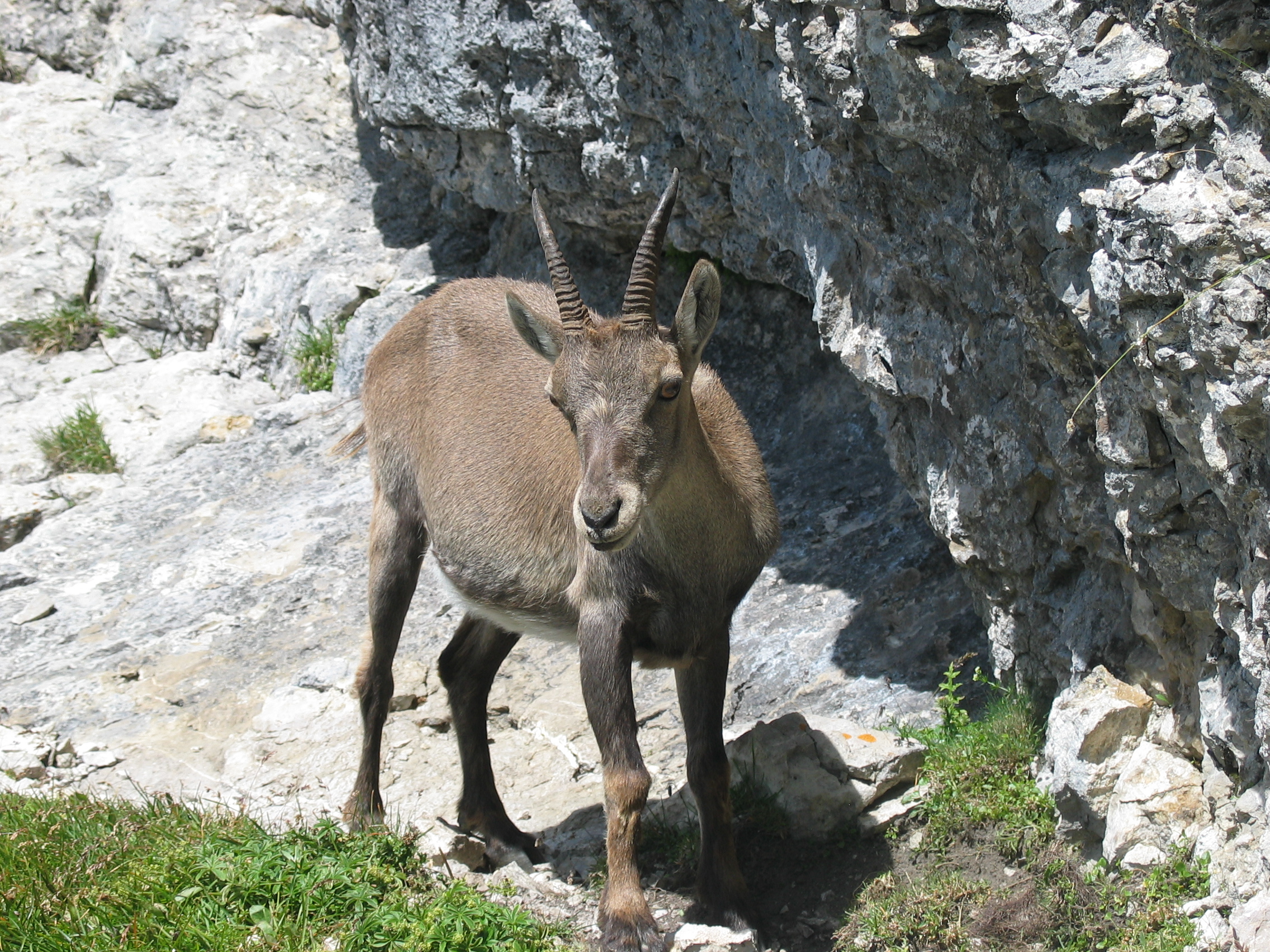- Capra (genus)
:"This article is about the Capra genus of animals and the Goat species. For other uses, see
Capra , orGoat (disambiguation) ."Taxobox
name = "Capra"

image_width = 250px
image_caption = Female ibex
regnum =Animal ia
phylum = Chordata
classis =Mammal ia
ordo = Artiodactyla
familia =Bovid ae
subfamilia = Caprinae
genus = "Capra"
genus_authority = Linnaeus, 1758
subdivision_ranks = Species
subdivision = See Species and subspeciesThe genus "Capra", usually called goats or wild goats, is agenus ofmammals composed of up to ninespecies , including theibex es, themarkhor , and thewild goat .The animal commonly known as the
domestic goat ("Capra aegagrus hircus") is adomesticated subspecies of thewild goat . All members of the "Capra" genus arebovid s (members of thefamily Bovidae ) and caprins (subfamilyCaprinae ). They are alsoruminant s, meaning they chew cud. These animals have a four-chambered stomach which plays a vital role in digesting, regurgitating and re-digesting their food. The Rocky Mountain Goat, despite its name, is not considered a true goat byscientist s as it belongs to the genus "Oreamnos ".pecies and subspecies
All species of the genus were included in just a single species formerly. Some would have recognized two species, the
Markhor on one side and all other forms included in one species on the other side. Today usually seven to nine species are acceptedMSW3 Grubb|id=14200767] :*
Spanish ibex ("Capra pyrenaicais")
*Alpine ibex ("Capra ibex")
*Nubian ibex ("Capra nubiana")
*Siberian ibex ("Capra sibirica")
*Walia ibex ("Capra walie")
*West Caucasian tur ("Capra caucasica")
*East Caucasian tur ("Capra cylindricornis")
*Wild goat ("Capra aegagrus")
*Markhor ("Capra falconeri")The
goats of the genus "Capra" have a complicated intern systematic, which is still not completely resolved. Recent studies based onmitochondrial DNA confirm that the Siberian ibex and the Nubian ibex represent distinct species, which are not very closely related to the similar Alpine ibex. The Alpine ibex however, is genetically not so far from the Spanish ibex and a need for grouping both together seems to be evident. West Caucasian tur seems to be closely related with the wild goat rather than with the East Caucasian tur. The genetic distance separating themarkhor , which was thought to be a separate branch of the genus, from other forms is small. ["Phylogenetic Reconstructions in the Genus Capra (Bovidae, Artiodactyla) Based on the Mitochondrial DNA Analysis". Russian Journal of Genetics, 2007, Vol. 43, No. 2, pp. 181–189. [http://www.springerlink.com/content/t66k1n07tqn8l564/ online] ] .Almost all wild goat species are
allopatric , only the range of the wild goat ("Capra aegagrus") overlaps with that of the East Caucasian tur ("Capra cylindricornis") and the range of the markhor ("Capra falconeri") overlaps with the Siberian ibex ("Capra siberica"). In both cases they form usually no hydrids or intermediate forms. In captivity however all "Capra" species can interbreed and produce fertile offspring. [V. G. Heptner: "Mammals of the Sowjetunion Vol. I UNGULATES". Leiden, New York, 1989 ISBN 9004088741]pecies and subspecies of goats
Similarity to sheep
Though closely related to sheep, to the point of causing occasional taxonomic confusion, goat behaviour is quite different. Sheep are primarily roaming grazers which travel in herds (also known as flocks), while goats are browsers like deer, eating branches and twigs, and tend to be more territorial. Like sheep, though, they have horns that continue to grow throughout their lifetime instead of antlers that fall off once a year. Unlike sheep, both male and female goats grow horns, and both sexes can have beards. Goats are
herd animals and survive better in a herd situation than alone. But they tend to be more aggressive with predators, and some sheep herders will run a few goats with the herd because after initially fleeing, the goats will stand up to a predator and possibly deter them, whereas sheep will continue to run. A herd typically has a Herd Queen, who leads the herd while browsing. They are also much more lively than sheep and their inquisitive nature makes them curiouspet s. Sheep and goats have the same horizontal slitpupil in theireye balls. Sheep tails go down, which is why they are sometimes docked, whereas goat tails go up.Domestication and uses
: "Main article:
Domestic goat "Along withsheep , goats were among the firstdomesticated animals , the domestication process starting at least 10,000 years ago. Goats may have first been domesticated in what is now northernIran . Easy human access to goathair ,meat , andmilk were the primary motivations. Goatskin s were popularly used until theMiddle Ages for water andwine bottles when traveling andcamping , and in certain regions asparchment for writing.The meat and milk of goats is used for consumption, goat milk having become more popular in recent years because it is easier to digest than cow milk. Many call goat milk a universal milk, because it can be given to most mammals. It is used to make a variety of
dairy products. The cheeses are known collectively aschevre ; examples include Rocamadour and feta. Goat meat intended for consumption is also known as 'chevon'. Goat skin is used to makekid glove s and other items of clothing.Fibre is obtained from several breeds:Angora goat s produce silk-likemohair ,Kashmir goat s producecashmere wool , whilePygora goat s produce a cashmere-type fiber. All are fine soft fibers that can be knitted into sweaters and other items. Some people keep goats as pets as well.References
Wikimedia Foundation. 2010.
